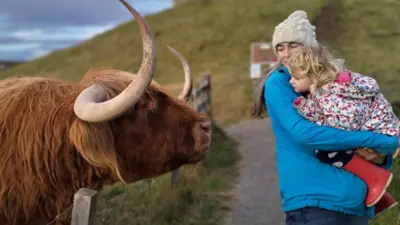We've updated our Privacy and Cookies Policy
We've made some important changes to our Privacy and Cookies Policy and we want you to know what this means for you and your data.
On patrol with Delhi's snake catchers
- Author, Tom Burridge
- Role, ґуПуґ«ГЅ News, Delhi
Picture the scene: A tiny wolf snake, not much bigger than a very large worm is surrounded by two reporters and five India Television cameras.
The snake has just been found by Delhi-based NGO Wildlife SOS by one of the entrances to the site of the Commonwealth Games athletes' village.
As the team of snake catchers' own video of the rescue shows, the wolf snake bit Ashard Khan who was tasked with picking the snake up.
From his yelp and shake of the hand it clearly hurt, but wolf snakes are not venomous.
However the snake's size, and the fact that it's harmless didn't stop the Indian media getting excited. Snakes in, or more accurately on the edge of a games venue equals big news.
Wildlife SOS have now rescued a total of seven snakes from games venues. Six from the site of the athletes village, the other from the tennis courts.
But unlike the wolf snake the others were all poisonous. Five spectacled cobras and one highly-venomous common krait.
"The fact that there's recently been lots of construction work on the site of the athletes' village is one possible reason why so many snakes are turning up there," says Kartick Satyanarayan, head of Wildlife SOS, India
"Also, the village is just by the Yamuna river and the monsoon season has just finished so the ground there is nice and wet."
Snake hotline
During the Commonwealth Games there is a 24-hour emergency hotline so people can report any unwelcome animal appearances at venues. There are maps of all the games sites across Delhi stuck onto the desk in the office.
When a call comes in, the charity's black animal rescue jeep is quickly deployed.
Most of the reports to Wildlife SOS have come from the Delhi Police, or other security personnel in charge of security.
The poisonous snakes are caught using a metal pole but the harmless ones are picked-up by hand.
All of the snakes that are caught by Wildlife SOS are eventually released back into the wild.
We drove in the charity's white 'animal ambulance' to a wildlife sanctuary on the edge of Delhi.
It is the nearest place to central Delhi which is a good habitat for snakes. The red-brick-colour earth is really dry but there's water nearby.
There are also plenty of trees and bushes which the snakes like to climb and cracks and holes in the earth for them to burrow into and hide.
Ironically the area is relatively close to the Commonwealth Games shooting range. However so far, the team haven't been called there.
Abishek Narayanan from Wildlife SOS is in charge of the operation to release the snakes.
A few months ago he was a physiotherapist but he gave it all up to become a snake catcher.
"Snakes are enigmatic, they're magnificent and beautiful. I think humans could learn a lot from snakes about how to survive in really adverse conditions, how to be on your own," he says.
His team carefully lift each snake out of its plastic container.
Some fly off into the undergrowth, making an incredible aeroplane-like noise.
Others sit still and have to be encouraged to move.
The cobras hiss and raise their hoods, reacting to any quick movements, before they eventually go their own way.
Common sight
It's illegal to own any snake in India. Snake charming has also been outlawed, although you'll still sometimes spot snake-charmers operating illegally near tourism sites across the Indian capital.
When the Commonwealth Games are over, much of Wildlife SOS's time will be spent rescuing snakes from people's homes.
During the monsoon season which runs from mid-July to mid-October the team will receive around 120 calls per month.
Cobras and wolf snakes are common across India.
During the games they haven't proved a rare sight at the athletes' village.
Remember the photos of dirty bathrooms? And the controversy and questions before the games began about whether the site was good enough for the athletes?
Well the venue is proving a popular site, and a good habitat for snakes.
Top Stories
More to explore
Most read
Content is not available








